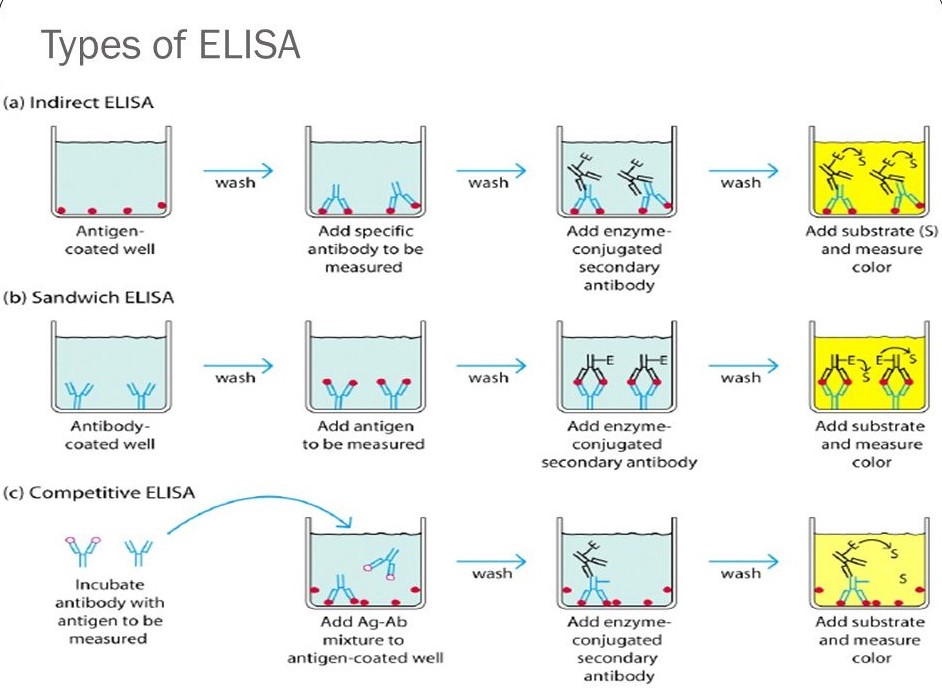
- Enzyme-linked immunosorbent assay, commonly known as ELISA or EIA is one of the most sensitive techniques for detecting antigen or antibody.
- The reaction between an enzyme-conjugated antibody and a colorless substrate generates a colored reaction product.
- Such color generating substrate after the reaction is called a chromogenic substrate.
- Alkaline phosphatase, horseradish peroxidase and β-galactocidase are few such enzymes used in ELISA.
- ELISA is similar in principle to Radioimmunoassay (RIA) but is safer and less costly.
- ELISA helps in both the qualitative (presence or absence) and quantitative (concentration) measurement of either antigen or antibody.
- A number of ELISA techniques have been developed as follows:
1. Indirect ELISA
- This technique is used for the detection and quantitative determination of antibody in the sample.
- Sample containing primary antibody (Ab1) is added to an antigen coated microtiter well after which the antigen attached to the well reacts with Ab1.
- Any unbound or free Ab1 is washed away and an enzyme-conjugated secondary antibody (Ab2) is added into the microtiter well.
- The secondary antibody conjugated with the enzyme binds with the primary antibody.
- Any free or unbound Ab2 is washed away and the specific substrate for the enzyme is added.
- The amount of colored reaction product that forms is measured by specialized spectrophotometric plate readers, that measures the absorbance of all the wells used.
- This method is used to detect the presence of serum antibodies against HIV, the causative agent of AIDS, which can be done within 6 weeks of infection.
2. Sandwich ELISA
- This method is used to detect or measure antigen in the sample.
- In this technique, instead of antigen, the antibody is immobilized on a microtiter well.
- A sample that contains the antigen to be detected or measured, is added and allowed to react with the immobilized antibody.
- The well is washed and a second enzyme-linked antibody specific for a different epitope on the antigen is added and allowed to react with the bound antigen.
- After any free second antibody is removed by washing, the enzyme specific substrate is added.
- This is called sandwich ELISA because the antigen to be detected is sandwiched between the two antibodies (bound antibody and enzyme-linked).
- Finally, the colored reaction product is measured by spectrophotometry.
3. Competitive ELISA
- In this technique, antibody is first incubated with the antigen (in the sample) in solution form and this mixture is then added to an antigen coated microtiter well.
- The more the antigen present in the sample, the less free antibody will be available to bind to the antigen-coated well.
- Enzyme-conjugated secondary antibody (Ab2) specific for the isotype of the primary antibody is added which is used to determine the amount of primary antibody bound to the well, as in indirect ELISA.
- In this technique, however, the higher the concentration of antigen in the original sample, the lower is the absorbance.
Applications of ELISA:
- Detection and measurement of antigen or antibody in the given sample.
- The concentration of serum antibodies can be determined in a virus test, e.g. HIV test.
- Detection of potential allergens in the food samples.
- For rapid presumptive screen of certain classes of drugs.
- Detection and quantification of substances such as peptides, antibodies, hormones, proteins etc.
